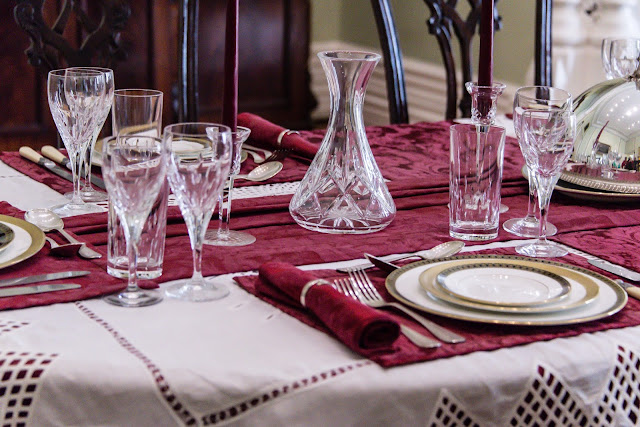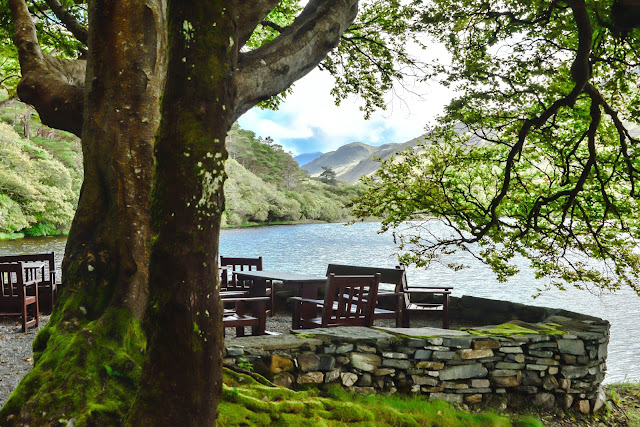IRELAND #3: THROUGH SLIGO AND GALWAY COUNTIES
This post features two days of coach travel through the west of Ireland. On the first day, we drove from Derry to Galway, a distance of 276 kilometers, through Donnegal, Sligo, and Galway Counties. En route, we visited a 6,000 year old court tomb followed by a tour of Drumcliff, summer home of poet laureate W.B.Yeats, and a visit to the Knock Shrine. On the next day, we drove through the fascinating Connemara Peninsula, just west of Galway. There we visited the beautiful Benedictine Abbey called Kylemore, followed by an engaging rural heritage centre.
First is a group photo taken during a stop for Irish coffee at Lough Inagh Lodge. You can see that our convivial group enjoyed this stop.
Creevy Keel is a 6,000 year old court tomb in County Sligo. It was composed of a cairn, an entrance passage, an oval court, and a double-chamber galley.
Our next stop was in Drumcliff, County Sligo, final resting place of William Butler Yeats (1865-1939). Yeats, dramatist and poet, and a strong Irish patriot, received the Nobel Prize in literature in 1923. He is buried outside the Church in Drumcliff.
In the churchyard there are many grave sites with celtic crosses.
Here you can see a round tower. It was built in the 10th or 11th century to help protect the monastery from Viking raids.
The churchyard is dominated by a richly decorated Irish High Cross dating from the 9th century.
A bronze statue of W.B. Yeats has been erected in the centre of the nearby town of Sligo.
We drove to the town of Sligo, population 20,000. We enjoyed lunch at a restaurant beside the Garavogue River near the JFK Parade.
We next visited the Shrine at Knock. It was built in the reputed 1879 apparition of the Virgin, St. Joseph, and St. John the Baptist to two local women. The Shrine, site of 1.5 million pilgrims every year, includes a church and an extremely large Basilica.
On the next day, we took a full day field trip to the Connemara Peninsula on the western edge of Ireland. This is a sparsely populated area which fulfills fabled popular images of a rugged seacoast, a mountainous terrain, moist valleys with rainbows, and traditional Irish language. We were particularly fascinated with the sheep and the sheep dogs, and the harvesting of myriad peat bogs.
We had coffee at the Lough Inagh Lodge where I took the group photo above and four other shots.
Béibphinn and Dave are patiently waiting for me to finish photographing!
Continuing, we visited the fantastic lakeside castle called Kylemore Abbey. It is a photographer's delight, so I have included many images here.
This 32 bedroom Gothic Revival castle (1867) was built by a 19th century Manchester tycoon as a romantic present for his wife. When she died, he sold it and it became an abbey for Benedictine nuns. Located on a beautiful lake, it is sheltered by nearby mountains in an extraordinarily picturesque setting. I couldn't decide which of my images I like best, so I have included a large number.
Note the Christ figure high overhead on the side of the mountain.
Many tourists constantly enter the castle/abbey to view the way of life inside.
The views of the lake from the castle are amazing!
The grounds are very large and tourists stroll along pathways on the shoreline and down to huge gardens. The complex includes a miniature Neo-Gothic church, completed in 1877.
The imitation ramparts below the castle look formidable.
The gardens were as spectacular as the buildings, but I ran out of photography time!
On our way back to Galway, we came across some of the famous Connemara horses in the fields. An Irish breed, they are known as athletic and versatile. Their calm disposition is legendary.
The final stop on our extended Connemara field trip was at a heritage centre called Cnoc Suain. An enterprising couple restored this property to create a legacy of the way of life in this area. The man gave us a complete summary of the growth, harvest, and use of peat over many centuries. In the cottage, his wife described traditional family life here, and then demonstrated the making of Irish soda bread. We were also treated to traditional Irish music and dancing.
The late afternoon sun was warm, and drew us past the walls, down the hill, and over the hills to town. End of this field trip.










































































3 Comments:
Great photos, Dad!
The photos, as we all anticipated, are terrific, and the notes are invaluable for filling in gaps in memory. Thanks, Paul, for adding to our good memories of this splendid trip by sharing your photos.
Carolyn
The photos, as we all anticipated, are terrific, and the notes are invaluable in filling in gaps in memory. Thanks, Paul, for adding to the memories of this splendid trip by sharing your photos and notes.
Post a Comment
Subscribe to Post Comments [Atom]
<< Home